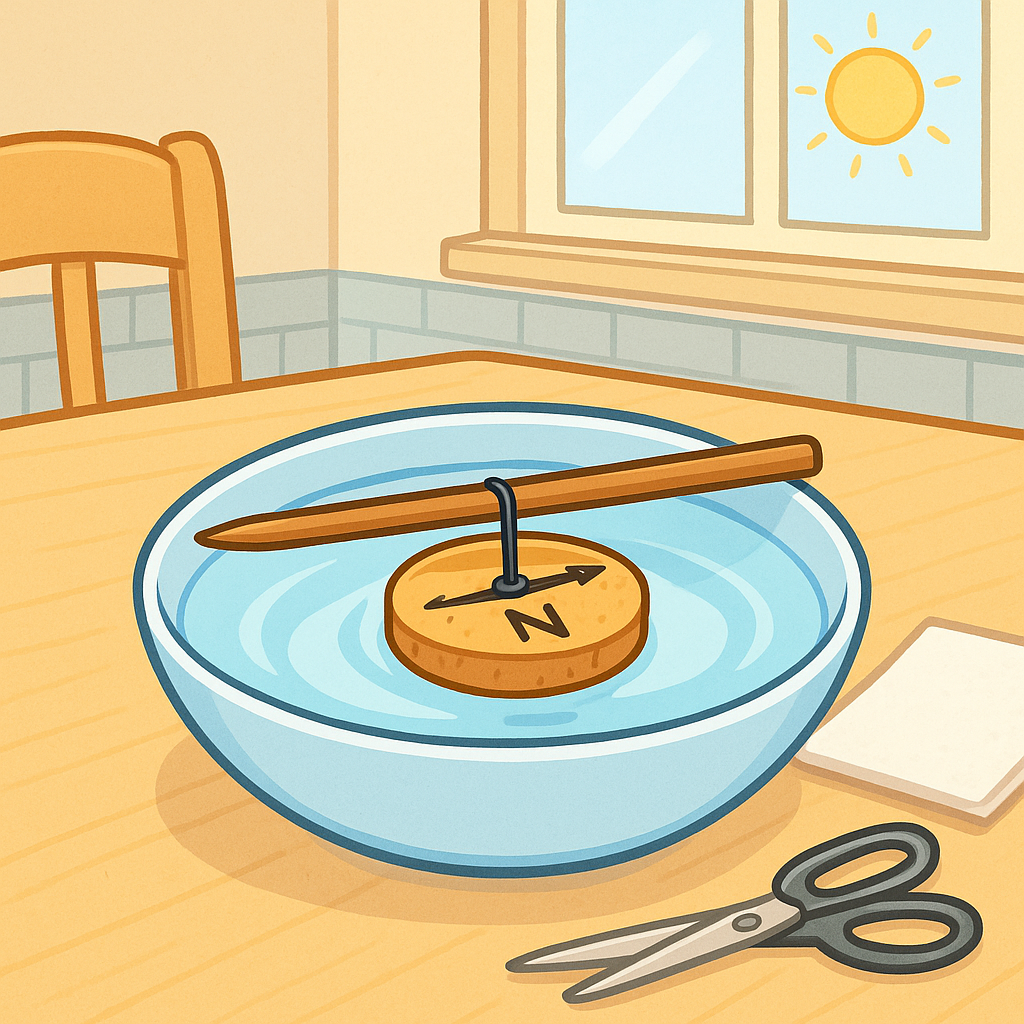 Homemade Compass:
Homemade Compass:
Make a Working Compass at Home with Simple Materials!
Make a Working Compass at Home with Simple Materials!
Did you know you can find magnetic north without a fancy compass or smartphone? In this hands-on experiment, your child will build a real working compass using just a sewing needle, a magnet, and a bowl of water! Perfect for grades 4–7, this project teaches about magnetism, navigation, and the science behind how explorers found their way before GPS. Parents: You’ll get clear teaching tips, safety notes, and printable resources to help your student not just follow steps, but understand the “why” behind this classic STEM activity.
Experiment Details
- Grade Level: 4th–7th Grade (adaptable K–8)
- Key Topics: Magnetism, Earth’s Magnetic Field, Navigation
- Estimated Time: 20–30 minutes
- Mess Factor: Low
Purpose: To learn how magnets interact with Earth’s magnetic field and to build a simple compass from everyday items.
Hypothesis: If a magnetized needle is placed on water so it can turn freely, it will point toward Earth’s magnetic north.
What You’ll Need
- Small sewing needle or straight metal pin
- Bar magnet or strong refrigerator magnet
- Shallow bowl or small plastic container
- About 1 cup of water
- Piece of cork or a small piece of foam (about 1 inch wide)
- Paper towel
- Pliers or tweezers (for safety, optional)
- Permanent marker (optional)

Step-by-Step Instructions
- **Magnetize the needle:** Hold the needle carefully (use pliers/tweezers if needed) and rub it with one end of the magnet about 30 times in the same direction.
Tip: Always rub in one direction for best results! - **Prepare your floating base:** Cut a slice of cork or foam, about 1 inch in diameter and 1/8 inch thick. (A wine cork or packing foam works great.)
- If you like, use a marker to draw a dot or N on one side to remember which side is north later.
- **Fill your bowl:** Pour about 1/2 inch of water into the shallow bowl.
- Push the needle carefully through the center of the cork so it is balanced and flat.
- Gently place the cork with the needle on the water so it floats freely.
- **Observe:** Watch as the needle slowly rotates and settles in one direction. It should point roughly north-south!
- Check with a real compass (or by the sun’s position) to verify which end is pointing north. Record your results.

Results & Scientific Explanation
The needle floats and spins until one end points north. That’s because you’ve turned it into a tiny magnet. Earth itself acts like a giant magnet, with an invisible magnetic field that reaches from pole to pole. When your needle is free to move, it lines up with these magnetic field lines—just like the needle in a store-bought compass!
- Why does this work? Rubbing the needle with a magnet lines up the atoms in the metal, creating a north and south pole. When floating, the needle can rotate and align itself with Earth’s magnetic field.
- Real-world connection: Sailors and explorers have used magnetic compasses for over 1,000 years to navigate oceans and deserts!
- Why use water? Water reduces friction so the needle turns freely.
Learning Objectives
- Understand how magnets interact with Earth’s magnetic field
- Build and test a floating compass
- Make and test a hypothesis, record observations, and draw a conclusion
- Learn safe handling of sharp objects and magnets
Teaching Tips for Parents
- Explain: Magnets have two poles—north and south. Earth acts like a huge magnet!
- Discuss how compasses help people find their way, and why that matters for explorers, hikers, or campers.
- Demonstrate that rubbing the needle both ways will NOT work—explain why direction matters.
- Ask your student to predict what will happen before testing. Encourage them to try the compass in different rooms or outdoors.
- Always supervise handling of sharp needles. Young kids should use tweezers/pliers and be closely supervised.
- Connect this experiment to maps and geography: have your child draw a simple map using their compass!
Standards Alignment
NGSS 3-5-ETS1-2: Generate and compare multiple solutions to a problem.
NGSS 4-PS3-2: Make observations to provide evidence that energy can be transferred.
NGSS 5-ESS1-1: Support an argument that differences in the apparent brightness of the sun are due to Earth’s rotation.
Printable Worksheet
Want a ready-to-use printable version for your class or homeschool?

Frequently Asked Questions
Yes—packing foam, a small plastic bottle cap, or even a piece of bread will work as long as it floats and is lightweight!
If the needle wasn’t magnetized enough, or you rubbed it in both directions, try again with a strong magnet and always rub in the same direction. Also, make sure there are no other magnets or electronics nearby interfering!
With supervision, yes. Parents should handle or closely supervise use of needles and magnets. Tweezers/pliers help avoid finger pokes.
Absolutely! Try it outside and see if it points the same way. The compass should work anywhere, but keep it out of strong wind or near metal objects.
Related Experiments
- Simple Circuit with a Battery and Bulb
- Dancing Raisins
- Lava Lamp in a Bottle
- See All Science Experiments
Share Your Results!
Did you try this experiment? Share your photos, results, or questions below!
⭐ What Parents & Teachers Are Saying
Recent Feedback
There are no reviews yet. Be the first one to write one.
